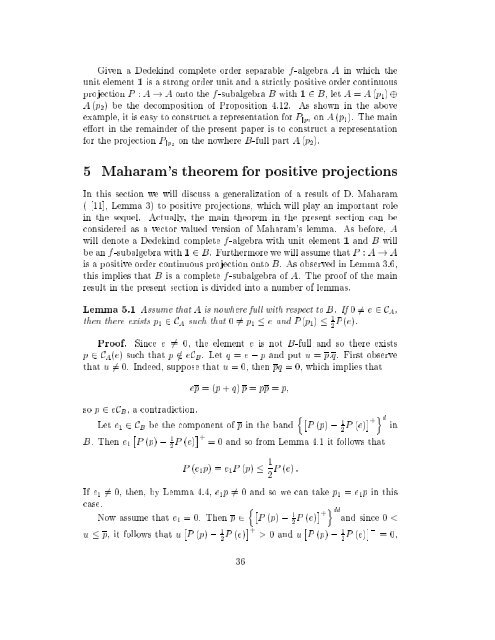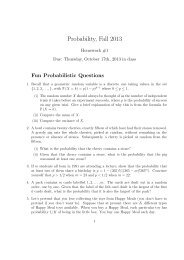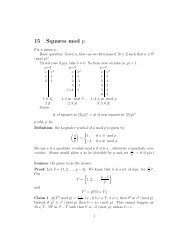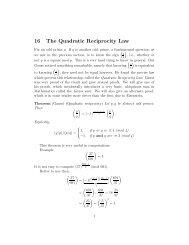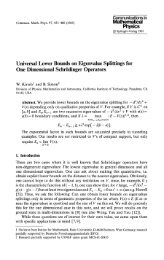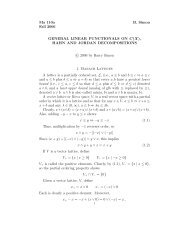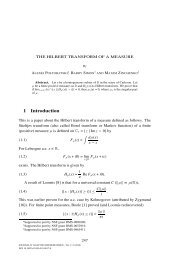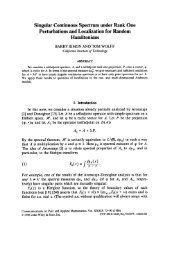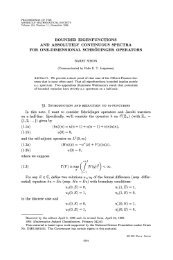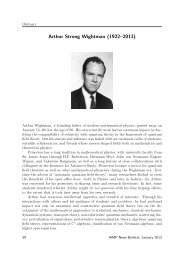Representations of positive projections 1 Introduction - Mathematics ...
Representations of positive projections 1 Introduction - Mathematics ...
Representations of positive projections 1 Introduction - Mathematics ...
Create successful ePaper yourself
Turn your PDF publications into a flip-book with our unique Google optimized e-Paper software.
Given a Dedekind complete order separable f-algebra A in which the<br />
unit element 1 is a strong order unit and a strictly <strong>positive</strong> order continuous<br />
projection P : A ! A onto the f-subalgebra B with 1 2 B, letA = A (p 1)<br />
A (p 2) be the decomposition <strong>of</strong> Proposition 4.12. As shown in the above<br />
example, it is easy to construct a representation for P p1 on A (p 1). The main<br />
e ort in the remainder <strong>of</strong> the present paper is to construct a representation<br />
for the projection P p2 on the nowhere B-full part A (p 2).<br />
5 Maharam's theorem for <strong>positive</strong> <strong>projections</strong><br />
In this section we will discuss a generalization <strong>of</strong> a result <strong>of</strong> D. Maharam<br />
( [11], Lemma 3) to <strong>positive</strong> <strong>projections</strong>, which will play an important role<br />
in the sequel. Actually, the main theorem in the present section can be<br />
considered as a vector valued version <strong>of</strong> Maharam's lemma. As before, A<br />
will denote a Dedekind complete f-algebra with unit element 1 and B will<br />
be an f-subalgebra with 1 2 B. Furthermore we will assume that P : A ! A<br />
is a <strong>positive</strong> order continuous projection onto B. As observed in Lemma 3.6,<br />
this implies that B is a complete f-subalgebra <strong>of</strong> A. The pro<strong>of</strong> <strong>of</strong> the main<br />
result in the present section is divided intoanumber <strong>of</strong> lemmas.<br />
Lemma 5.1 Assume that A is nowhere full with respect to B. If 0 6= e 2CA,<br />
then there exists p1 2CA such that 0 6= p1 e and P (p1) P (e).<br />
Pro<strong>of</strong>. Since e 6= 0, the element e is not B-full and so there exists<br />
p 2CA(e) such that p =2 eCB. Let q = e ; p and put u = p:q. First observe<br />
that u 6= 0. Indeed, suppose that u =0,then pq =0,which implies that<br />
so p 2 eCB, a contradiction.<br />
ep =(p + q) p = pp = p<br />
Let e 1 2CB be the component <strong>of</strong> p in the band<br />
1<br />
2<br />
n P (p) ; 1<br />
2 P (e) +o d<br />
B. Then e1 P (p) ; 1 +<br />
P (e) =0andso from Lemma 4.1 it follows that<br />
2<br />
P (e 1p) =e 1P (p)<br />
1<br />
P (e) :<br />
2<br />
If e 1 6= 0,then, by Lemma 4.4, e 1p 6= 0and so we can take p 1 = e 1p in this<br />
case.<br />
Now assume that e 1 =0. Then p 2<br />
in<br />
n P (p) ; 1<br />
2 P (e) +o dd<br />
and since 0 <<br />
u p, it follows that u P (p) ; 1 +<br />
P (e) > 0 and u P (p) ; 2 1<br />
2P (e) ; = 0,<br />
36


